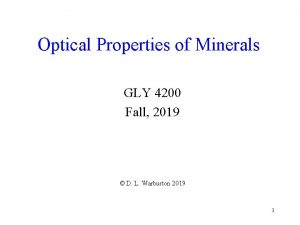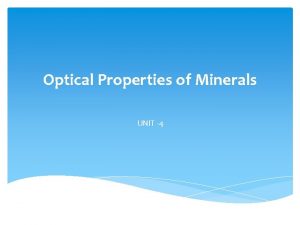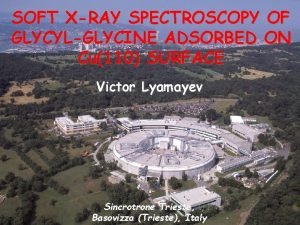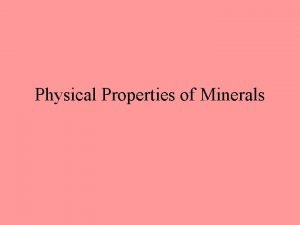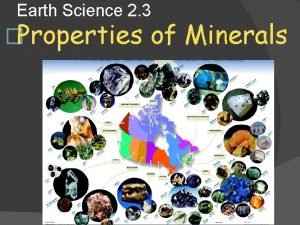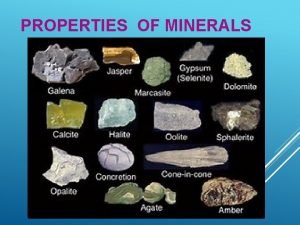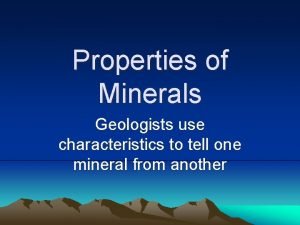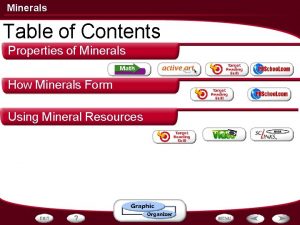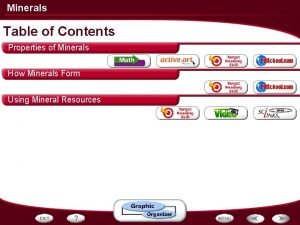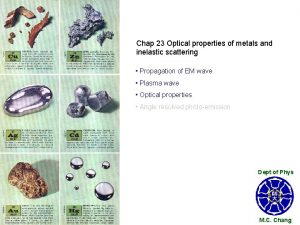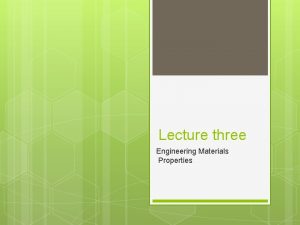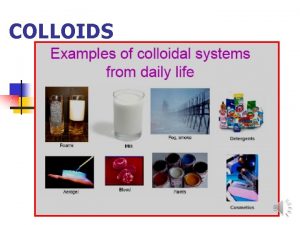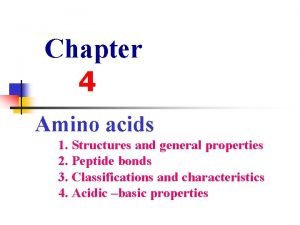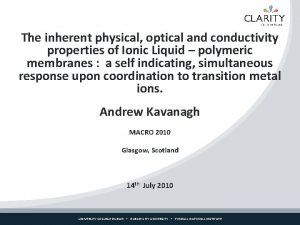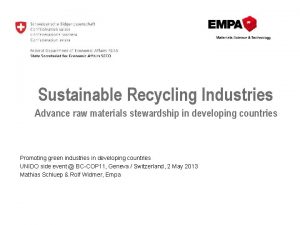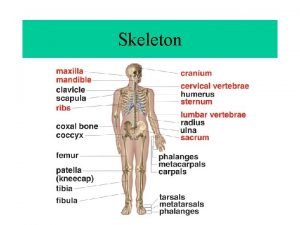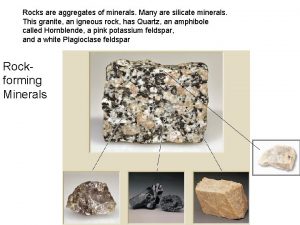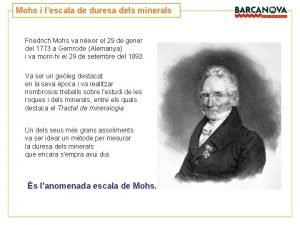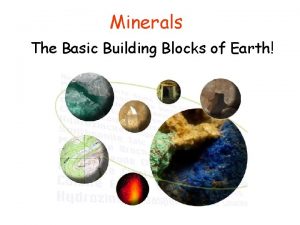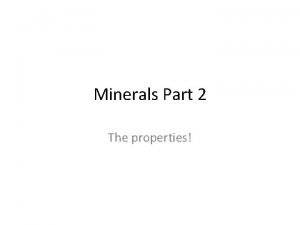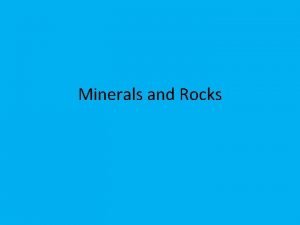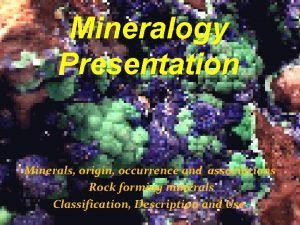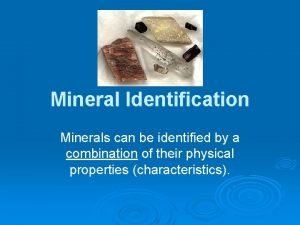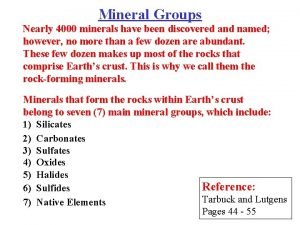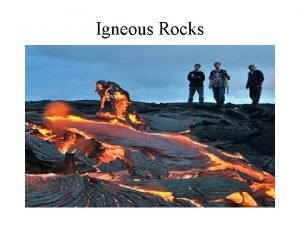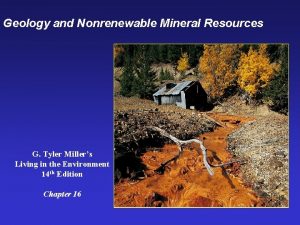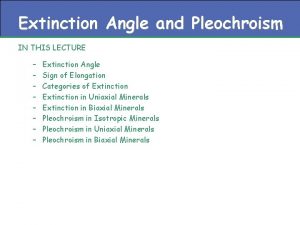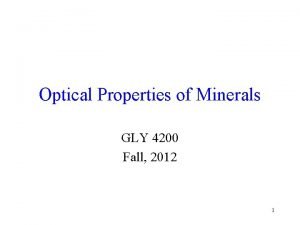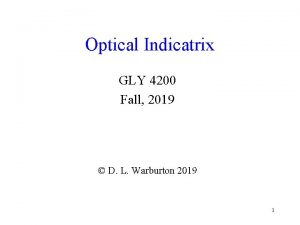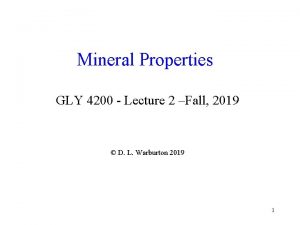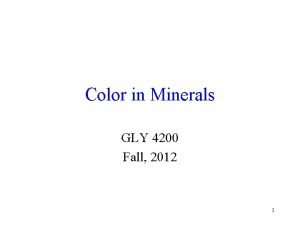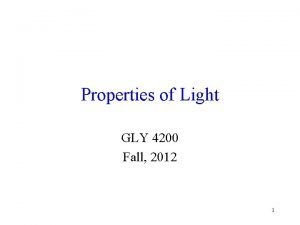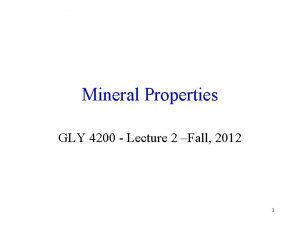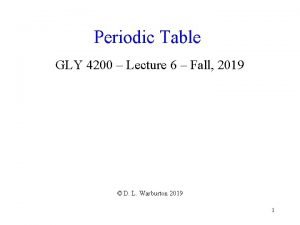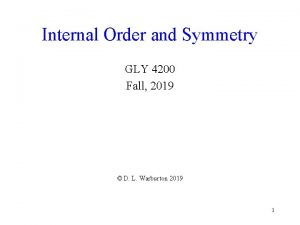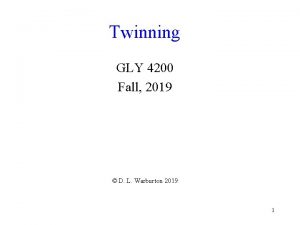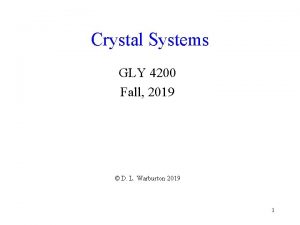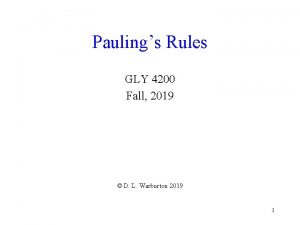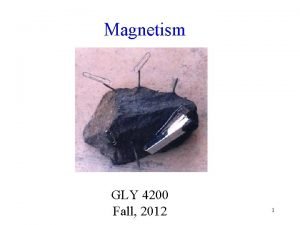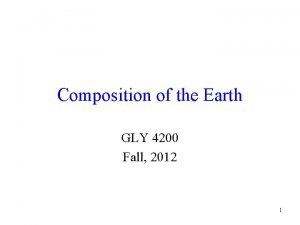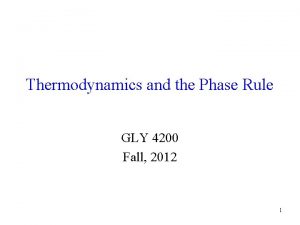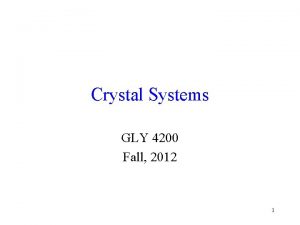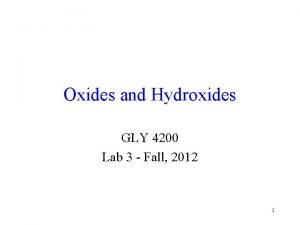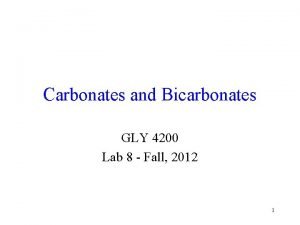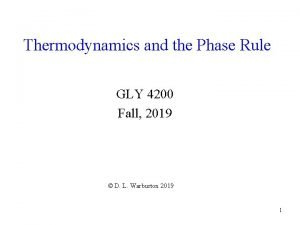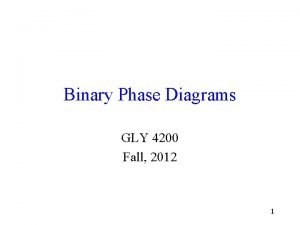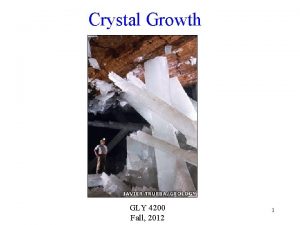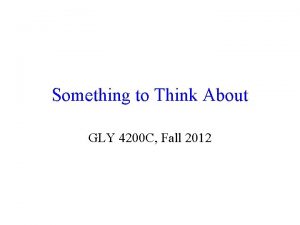Optical Properties of Minerals GLY 4200 Fall 2019









































- Slides: 41

Optical Properties of Minerals GLY 4200 Fall, 2019 © D. L. Warburton 2019 1

Path Differences In Crystals • Waves entering an anisotropic crystal will generally experience two indices of refraction in two perpendicular directions • Even plane-polarized radiation will be split into the Ordinary (O) and Extraordinary (E) vibrating 2

Retardation • Path differences upon passing through a crystal are called retardation (of the slower ray relative to the faster) • Δ = λ in this case 3

Accessory Plates • Quartz sensitive tint, gypsum plate, 1 st order red has Δ = 550 nm • Mica or quarter-wave plate has Δ = 150 nm (some plates in the lab have Δ = 137 nm) • Quartz wedge has variable Δ • Generally, the slow direction is indicated on the plate (N) – the fast direction (n) is unmarked, but is perpendicular 4

Accessory Plate Photo • Left to right: Quarter wave plate; full wave sensitive tint plate; quartz wedge • Viewed in crossednicols 5

Quartz Sensitive Tint Plate • Usually made of gypsum, mica, or quartz • Mineral is cut parallel to the optic axis of the crystal, to such a thickness that the O-rays and E-rays for green light (λ = 540 nm) are out of phase by exactly one wavelength • The analyzer therefore extinguishes green light, but permits other wavelengths to pass through to some extent • When using white light this causes the field of view to appear red (white light minus green light) • Isotropic, non-birefringent materials also appear red 6

Quarter-wave Plate • Made form a flake of mica that is cleaved to such a thickness that the O-rays and E-rays emerge a quarter of a wavelength out of phase • This corresponds to a pale grey interference color • This plate is especially useful for examining specimens showing bright interference colors, because they are moved only a short distance along the scale • The plate can be used to enhance the contrast between regions of the specimen 7

Quartz Wedge Plate • The quartz wedge is cut so that it varies in thickness from about 0. 01 mm to about 0. 08 mm and covers several orders of retardation colors • As the wedge is inserted into the slot in the microscope it produces progressively higher retardations, and the position at which complete extinction occurs is noted • Michel Levy produced a color chart which plots the thickness of an isotropic specimen, its birefringence and its retardation in nanometers • Once two of these variables is known, the third can be easily determined 8

Calculating Δ • Δ = c (TN - Tn) • Where § TN = time for the slow wave to pass through the xtal § Tn = time for the fast wave to pass through the xtal • If the thickness of the crystal is t, then: § c. N = t/TN and cn = t/Tn 9

Calculating Δ continued • Δ = c (t/c. N – t/cn) = t (c/c. N – c/cn) • But N = c/c. N and n = c/cn • Therefore, Δ = t(N –n) 10

Sample Calculation • For quartz, N = 1. 553 and n = 1. 544 • Thickness of a standard section = 30 microns = 0. 03 mm • Δ= (1. 553 – 1. 544) x 0. 03 mm = 2. 7 x 10 -4 mm = 270 nm • For calcite, N = 1. 658 and n = 1. 486 • Δ = (1. 658 – 1. 486) (0. 03) = (0. 172) (0. 03) = 5. 160 x 10 -3 mm = 5160 nm 11

Transmission of Light • Crystal viewed 45 off extinction (where interference colors are brightest) with nicols crossed (CN) § L = 100 sin 2 Δ/λ 180 o (L = percent transmission) • For parallel nicols (PN) § L = 100 cos 2 Δ/λ 180 12

Plot of Transmission vs. λ • Note: Curves labeled 10 λ, 9λ, etc. should say 10 Δ/λ, 9 Δ/λ, etc. • Solid line, Δ = 4000 nm • Dashed line, Δ = 200 nm 13

Use of Accessory plates • Anisotropic crystals will show their most intense, or brightest, interference colors at a position 45 off extinction • When an accessory plate is inserted into the light path, with the fast direction of the crystal and accessory plate parallel, the retardations produced by each will add 14

Example of Addition • If the crystal Δ= 250 nm (1 yellow) and the accessory Δ = 550 nm the total retardation will be 800 nm (2 green) • The accessory will always raise the retardation color to a higher retardation if the fast directions are parallel 15

Michael Levy Color Chart • As retardation increases, we see colors in order from blue to red • After one set of colors, the pattern repeats, so we get first-order, second-order, etc. 16

Subtraction • If the slow direction of the crystal is parallel to the fast direction of the accessory plate, we will see a retardation color equal to the absolute value of the difference of their Δ values 17

Example of Subtraction - 1 • Δ crystal = 300 nm (1 yellow) • Δ accessory = 150 nm • 300 – 150 = 150 (1 gray) 18

Example of Subtraction - 2 • • • Δ crystal = 200 nm (1 gray) Δ accessory = 550 nm 200 – 550 mm = 350 nm (1 yellow) In this case the subtraction has enhanced the color! However, if we rotate the stage 90 degrees, so that the fast directions are parallel, the addition process will occur and Δ total = 550 + 200 = 750 (2 blue green) 19

Relation Between Addition and Subtraction • Thus, the addition process always produces a higher color than the subtraction process 20

Sign of Elongation • Crystals which are elongated are said to be length - slow if the slow direction of the crystal is parallel to the long direction of the crystal • Elongated crystals are length – fast if the fast direction of the crystal is parallel to the long direction of the crystal 21

Orthoscopic Observation • Normal use of a microscope is on the orthoscopic mode – the light from the source of illumination is parallel, or as nearly parallel as is possible 22

Conoscopic Observation • An alternate way of using the microscope involves conoscopic illumination • In this case the condensing lens is moved closer to the objective lens, and the illumination occurs along the surface of a cone 23

Objective Lenses • Most petrographic microscopes have at least three interchangeable objective lenses of different magnifications and numerical apertures • Aperture is the opening, or width, of a lens 24

Angular Aperture • Aperture may be measured in terms of the angular aperture, μ • Numerical Aperture = n sin μ § Where n is the lowest index of refraction of any medium filling the gap between the objective and the thin section § Generally this medium will be air (dry case) or an immersion oil 25

Angular Aperture Diagram • Angular aperture is the size of the cone of light that the lens can accept (30° or 118°) 26

Maximum N. A. Value • Sin function has a maximum value of 1. 0, so N. A. values cannot exceed 1. 0 for the dry case • Oil immersion lens are available with magnification of 100 x and N. A. values of 1. 30 27

Importance of N. A. • Orthoscopic – determines the resolution (smallest detail can be distinguished) of a microscope § The higher the N. A, the better the resolution • Conoscopic – determines how much of an interference figure can be seen § The larger the N. A. value, the more of the figure you can see § This makes identification easier 28

Oil Immersion Lens • To use the very high power, larger N. A. lens it is necessary to use immersion oil with n >1. 3 • The condensing lens must have an N. A. comparable with the objective lens 29

Properties of Immersion Oils • Oils used are generally organic oils of various types • Oils higher than 1. 8 often contain polychlorinated biphenyls (P. C. B. ’s) and must be used with great caution • P. C. B. 's have been shown to be powerful carcinogens 30

Depth of Focus • The depth of focus is the range over which objects are in focus • It is an inverse function of N. A. • Low power lens are typically easy to focus • High power lens have a very small (10 microns for a 40 -45 x objective) depth of focus 31

Extinction Angle • Non-isotropic substances will go into extinction (show 1 black interference colors) four times as the stage is rotated in a full circle, or once every ninety degrees • Frequently a grain will have a prominent linear feature which can serve as a reference line • Such linear features are generally either crystal faces or the lines of intersection of cleavage planes with the crystal plate surface • The latter are called cleavage traces 32

Parallel Extinction • The crystal direction is parallel to the crosshair at extinction • τ =0 • Also called straight extinction • Not possible in triclinic crystals 33

Symmetric Extinction • When a crystal shows two crystal directions (such as cleavage traces) the extinction position may bisect the angle between the crystal directions • τ ≠ 0 • Not possible in triclinic crystals 34

Inclined Extinction • A single crystal direction will not be parallel to a crosshair at extinction • This can occur only in biaxial crystals • τ ≠ 0 35

Undulatory Extinction • Extinction will look like a wave passing across a crystal as the stage is rotated • Often results from deformation of a crystal • Quartz frequently shows undulatory extinction 36

Natural Color • Many minerals are transparent at the standard thickness of a thin section (30 microns) • Absence of color is not reported • Presence of color should be reported as natural color, when viewed in plane polarized light 37

Absorption • Minerals displaying natural color may change the intensity of their color as the stage is rotated • Example: A light green color may become darker green • Such a change can be noted as a change in absorption 38

Pleochroism • Many colored anisotropic minerals, viewed in PP light, will show a change in color as the stage is rotated • The change in color is called diachroism or pleochroism (literally meaning many colors) 39

Describing Pleochroism • For pleochroic minerals the observed color range should be reported • For example: § Inky blue to dark brown § Colorless to light yellowish-green 40

Pleochroism Video • Iolite is the gem variety of Cordiertite • This mineral displays the one of the strongest examples of pleochroism seen in nature • This big 82 carat Iolite from Madagascar shows this typical dichroism , from a nice deep blue to a transparent-light brown 41
 Optical properties of minerals
Optical properties of minerals Basal section mineral
Basal section mineral Coordination isomerism in coordination compounds
Coordination isomerism in coordination compounds Gly
Gly Gly
Gly 9300 to 34800
9300 to 34800 Juniper
Juniper Issai standards
Issai standards Checkpoint 4800
Checkpoint 4800 Issai 400
Issai 400 Properties of minerals
Properties of minerals Cleavage definition science
Cleavage definition science Properties of minerals
Properties of minerals What does cleavage mean in minerals
What does cleavage mean in minerals How are minerals formed
How are minerals formed Physical properties of minerals graphic organizer answer
Physical properties of minerals graphic organizer answer Optical properties of metals and nonmetals
Optical properties of metals and nonmetals Optical properties of engineering materials
Optical properties of engineering materials Kinetic properties of colloids
Kinetic properties of colloids Optical properties of amino acids
Optical properties of amino acids Inherent optical properties
Inherent optical properties Intensive vs extensive
Intensive vs extensive Physical property and chemical property
Physical property and chemical property Streak of minerals
Streak of minerals Conflict minerals
Conflict minerals Storage of minerals
Storage of minerals Ravine erosion
Ravine erosion Quartzite rock cycle
Quartzite rock cycle Rocks are aggregates of minerals
Rocks are aggregates of minerals The rock cycle song
The rock cycle song Rocks
Rocks La escala de mohs minerales
La escala de mohs minerales Luster
Luster Fracture minerals
Fracture minerals Special minerals
Special minerals Importance of mineralogy
Importance of mineralogy Minerals can be identified by
Minerals can be identified by Nearly 4000 minerals have been named.
Nearly 4000 minerals have been named. Igneous rock
Igneous rock Economic minerals
Economic minerals Carbohydrate vitamin
Carbohydrate vitamin Types of extinction in geology
Types of extinction in geology
